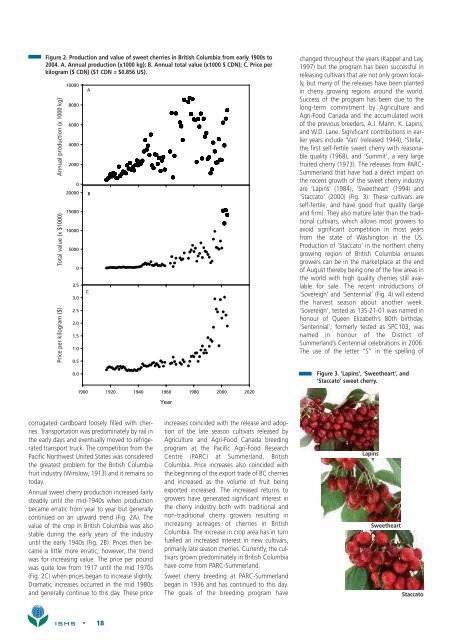Chronica - Acta Horticulturae
Chronica - Acta Horticulturae
Chronica - Acta Horticulturae
You also want an ePaper? Increase the reach of your titles
YUMPU automatically turns print PDFs into web optimized ePapers that Google loves.
Figure 2. Production and value of sweet cherries in British Columbia from early 1900s to<br />
2004. A. Annual production (x1000 kg); B. Annual total value (x1000 $ CDN); C. Price per<br />
kilogram ($ CDN) ($1 CDN = $0.856 US).<br />
Annual production (x 1000 kg)<br />
Total value (x $1000)<br />
Price per kilogram ($)<br />
10000<br />
8000<br />
6000<br />
4000<br />
2000<br />
0<br />
20000<br />
15000<br />
10000<br />
5000<br />
0<br />
3.5<br />
3.0<br />
2.5<br />
2.0<br />
1.5<br />
1.0<br />
0.5<br />
0.0<br />
A<br />
C<br />
B<br />
changed throughout the years (Kappel and Lay,<br />
1997) but the program has been successful in<br />
releasing cultivars that are not only grown locally,<br />
but many of the releases have been planted<br />
in cherry growing regions around the world.<br />
Success of the program has been due to the<br />
long-term commitment by Agriculture and<br />
Agri-Food Canada and the accumulated work<br />
of the previous breeders, A.J. Mann, K. Lapins,<br />
and W.D. Lane. Significant contributions in earlier<br />
years include ‘Van’ (released 1944), ‘Stella’,<br />
the first self-fertile sweet cherry with reasonable<br />
quality (1968), and ‘Summit’, a very large<br />
fruited cherry (1973). The releases from PARC-<br />
Summerland that have had a direct impact on<br />
the recent growth of the sweet cherry industry<br />
are ‘Lapins’ (1984), ‘Sweetheart’ (1994) and<br />
‘Staccato’ (2000) (Fig. 3). These cultivars are<br />
self-fertile, and have good fruit quality (large<br />
and firm). They also mature later than the traditional<br />
cultivars, which allows most growers to<br />
avoid significant competition in most years<br />
from the state of Washington in the US.<br />
Production of ‘Staccato’ in the northern cherry<br />
growing region of British Columbia ensures<br />
growers can be in the marketplace at the end<br />
of August thereby being one of the few areas in<br />
the world with high quality cherries still available<br />
for sale. The recent introductions of<br />
‘Sovereign’ and ‘Sentennial’ (Fig. 4) will extend<br />
the harvest season about another week.<br />
‘Sovereign’, tested as 13S-21-01 was named in<br />
honour of Queen Elizabeth’s 80th birthday.<br />
‘Sentennial’, formerly tested as SPC103, was<br />
named in honour of the District of<br />
Summerland’s Centennial celebrations in 2006.<br />
The use of the letter “S” in the spelling of<br />
Figure 3. ‘Lapins’, ‘Sweetheart’, and<br />
‘Staccato’ sweet cherry.<br />
1900 1920 1940 1960 1980 2000 2020<br />
Year<br />
corrugated cardboard loosely filled with cherries.<br />
Transportation was predominately by rail in<br />
the early days and eventually moved to refrigerated<br />
transport truck. The competition from the<br />
Pacific Northwest United States was considered<br />
the greatest problem for the British Columbia<br />
fruit industry (Winslow, 1913) and it remains so<br />
today.<br />
Annual sweet cherry production increased fairly<br />
steadily until the mid-1940s when production<br />
became erratic from year to year but generally<br />
continued on an upward trend (Fig. 2A). The<br />
value of the crop in British Columbia was also<br />
stable during the early years of the industry<br />
until the early 1940s (Fig. 2B). Prices then became<br />
a little more erratic; however, the trend<br />
was for increasing value. The price per pound<br />
was quite low from 1917 until the mid 1970s<br />
(Fig. 2C) when prices began to increase slightly.<br />
Dramatic increases occurred in the mid 1980s<br />
and generally continue to this day. These price<br />
increases coincided with the release and adoption<br />
of the late season cultivars released by<br />
Agriculture and Agri-Food Canada breeding<br />
program at the Pacific Agri-Food Research<br />
Centre (PARC) at Summerland, British<br />
Columbia. Price increases also coincided with<br />
the beginning of the export trade of BC cherries<br />
and increased as the volume of fruit being<br />
exported increased. The increased returns to<br />
growers have generated significant interest in<br />
the cherry industry both with traditional and<br />
non-traditional cherry growers resulting in<br />
increasing acreages of cherries in British<br />
Columbia. The increase in crop area has in turn<br />
fuelled an increased interest in new cultivars,<br />
primarily late season cherries. Currently, the cultivars<br />
grown predominately in British Columbia<br />
have come from PARC-Summerland.<br />
Sweet cherry breeding at PARC-Summerland<br />
began in 1936 and has continued to this day.<br />
The goals of the breeding program have<br />
Lapins<br />
Sweetheart<br />
Staccato<br />
ISHS • 18
















